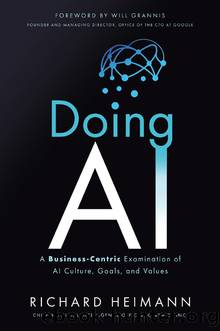Doing AI by Richard Heimann

Author:Richard Heimann
Language: eng
Format: epub
ISBN: 9781637740071
Publisher: BenBella Books
Published: 2021-09-22T00:00:00+00:00
The Streetlight Effect
Today, insiders acknowledge that there are missing pieces to achieving general intelligence, but no one can say with certainty what they are, how they fit together, or even if something like deep learning is the best starting point. Like Marcus, Pedro Domingosâa prominent insider and author of The Master Algorithmâadvocates for an integrated, hybrid approach. He says that deep learning doesnât allow different pieces of knowledge to be composed in arbitrary ways like symbolist solutions do; nor does it evolve structure like evolutionary algorithms, properly handle uncertainty like Bayesian methods, or generalize to very different situations like analogical reasoning. Domingos suggests that combined learning is more comprehensive and necessary to make progress toward general intelligence.
Yann LeCun, chief AI scientist at Facebook and inventor of Convolutional Neural Networks, is advocating for integration as well. LeCun considers unsupervised learning to be a rather vexing issue on the path of AGI.4 LeCun uses a cake metaphor for intelligence to describe supervised learning as the icing and reinforcement learning as the cherry, whereas unsupervised machine learning is the actual cake.5 LeCun says we need to solve the unsupervised learning problem before we can even think of getting to true AI.
Reinforcement learning (RL), the cherry on the cake, is a learning paradigm that focuses on how so-called agents take action within an environment to maximize a cumulative reward. For example, RL uses recursive interaction with the environment to fit a function that estimates the expected return on taking some random actions. By taking random actions, RL does not require any knowledge of the environment prior to learning. However, the agent is strictly associated with its environment. Imagine you want to teach an agent to play Mario Bros.6 The agent can interact within the constraints of the game by choosing random actions such as run, jump, or duck, doing so thousands of times to achieve the goal of completing the stage. Unfortunately, agents are most often found in virtual environments rather than real-world ones, and some agent trained on Mario Bros would not be good for other problems that do not fit the problem characteristics of games. Therefore, an agent outside the original environment is useless, or not an agent at all.
The actual cake, the unsupervised machine learning, does not have the same demands on knowledge representation, such as logic and rules in symbolic solutions, or the specific demands on labeled data required for supervised machine learning. Unsupervised machine learning attempts to partition the data into largely homogenized groups or organize data into similar representations. More colloquially, think of birds of a feather flocking together. Structure is learned directly from the data and not defined in advance with classes and labels.7
An early, mainstream example of unsupervised machine learning is the famous Google cat.8 In 2012, Google proved an artificial neural network with ten million randomly selected video thumbnails from YouTube. The algorithm was able to discover a variety of categories including human faces, which it predicted with an accuracy of 81.7 percent, and cats, which it predicted correctly 74.
Download
This site does not store any files on its server. We only index and link to content provided by other sites. Please contact the content providers to delete copyright contents if any and email us, we'll remove relevant links or contents immediately.
Zero to IPO: Over $1 Trillion of Actionable Advice from the World's Most Successful Entrepreneurs by Frederic Kerrest(4288)
Machine Learning at Scale with H2O by Gregory Keys | David Whiting(4176)
Never by Ken Follett(3788)
Harry Potter and the Goblet Of Fire by J.K. Rowling(3773)
Ogilvy on Advertising by David Ogilvy(3508)
Shadow of Night by Deborah Harkness(3302)
The Man Who Died Twice by Richard Osman(2996)
Book of Life by Deborah Harkness(2867)
The Tipping Point by Malcolm Gladwell(2827)
Will by Will Smith(2791)
0041152001443424520 .pdf by Unknown(2784)
My Brilliant Friend by Elena Ferrante(2773)
How Proust Can Change Your Life by Alain De Botton(2742)
Purple Hibiscus by Chimamanda Ngozi Adichie(2649)
How to Pay Zero Taxes, 2018 by Jeff A. Schnepper(2602)
Hooked: A Dark, Contemporary Romance (Never After Series) by Emily McIntire(2496)
Rationality by Steven Pinker(2291)
Borders by unknow(2227)
Can't Hurt Me: Master Your Mind and Defy the Odds - Clean Edition by David Goggins(2225)
